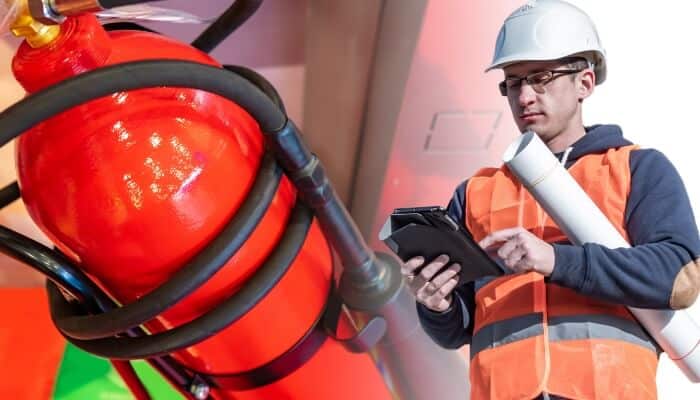Expert Fire Extinguisher Installation in Clayton, NC
There are more factors to consider in fire extinguisher installation than you've likely considered.
- The location, of course, is one of the most important. You want to make sure it is easily accessible but also in a spot where it is unlikely to be damaged or blocked.
- Another important factor is to take into account where hazards may exist, such as in the kitchen or near electrical equipment.
- You also want to make sure that the extinguisher is visible and easily identifiable in an emergency situation.
It's important to do your research and consult with the experts here at Safeguard to ensure that you are installing the extinguisher in the best possible location for your particular environment. Don't take this decision lightly, as it could be a matter of life or death in the case of a fire!

North Carolina Fire Extinguisher Installation Regulations & Codes
Fire safety is a crucial element in any building, and North Carolina has established strict regulations and codes for fire extinguishers. It's essential to know the requirements set forth by the state to ensure the safety of your property and its occupants. North Carolina's regulations include laws regarding the type of fire extinguishers needed, the number required in each building, and their placement. It's important to note that these regulations apply to all types of buildings, including commercial, industrial, and residential. Being aware of these regulations and fulfilling the requirements can go a long way in preventing fires and avoiding potential disasters.
As per Section 906 of the North Carolina Fire Code, the requirements for fire extinguisher installation include:
- Fire extinguishers must be installed in their designated location, which is determined by the building size, occupancy, and hazard potential.
- The type and number of fire extinguishers installed must comply with the fire code requirements based on the hazard potential. For example, a Class C hazard requires a clean agent extinguishing system whereas a Class K hazard requires a wet chemical extinguishing system.
- Fire extinguishers must be clearly identified with their type, rating, and instructions for use. The tag on the extinguisher must indicate the date of the last inspection and maintenance activity.
It's essential to note that these requirements may have variations depending on the type of building or occupancy. it's always best to consult with Safeguard to ensure that you are in compliance with applicable fire code requirements.
Choosing the Correct Fire Extinguisher
It's important to have the right tools in your arsenal, that is doubly true for fire safety! However, with so many different types of fire extinguishers available, it can be challenging to know which one to choose. Different types of fires require different types of extinguishers, so it's crucial to understand the classifications and potential hazards. For example, a Class A fire involves ordinary combustibles like wood or paper, while a Class B fire involves flammable liquids such as gasoline or oil.
By consulting Safeguard Fire Protection Services, you can ensure that you're equipped to handle any potential emergency. We can help you select the perfect amount and types of fire extinguishers, make sure they end up in the right place, and stay on top of annual inspections to help you comply with requirements without adding too much to your busy schedule!
Fire Extinguisher Sales & Service FAQs
The price of new fire extinguishers varies based on the kind, size, and quality of the extinguisher. In general, inexpensive household fire extinguishers cost $20 to $100 or more. Larger, industrial- or commercial-grade extinguishers can run you anything from several hundred to over a thousand dollars per. Different pricing ranges may apply to specialty extinguishers, such as those created for particular kinds of fires (such as kitchen fires or electrical fires). It's critical to select the appropriate size and kind of fire extinguisher for your purposes and to confirm that it conforms with all applicable safety laws.
Fire extinguishers should be recharged whenever they are used, even partially, regardless of the amount discharged. Additionally, they should be inspected annually by a certified professional to ensure they are fully pressurized and in good working condition. Depending on the type of fire extinguisher and local regulations, they may require more frequent inspections and maintenance. It's crucial to adhere to these guidelines to guarantee that fire extinguishers are always ready for use in case of emergency.
Fire extinguishers typically have a lifespan of 5 to 15 years, depending on the type and manufacturer. Check the manufacturer's label or the extinguisher's manual for the recommended replacement schedule. Exposure to environmental conditions, maintenance, and usage can affect their longevity. Even if they haven't reached their expiration date, extinguishers should be visually inspected regularly for signs of damage or corrosion and replaced if necessary to ensure they remain effective in an emergency.
To dispose of an old or used fire extinguisher, first, check if it can be recharged or reused. If it cannot, start by fully discharging the extinguisher outdoors by squeezing the handle to release any remaining pressure. Once it's empty, remove the head to ensure it can't be reused. You can then take the extinguisher to a recycling center that handles metal items or a hazardous waste disposal facility. Never throw a fire extinguisher in the regular trash, as it can be dangerous.